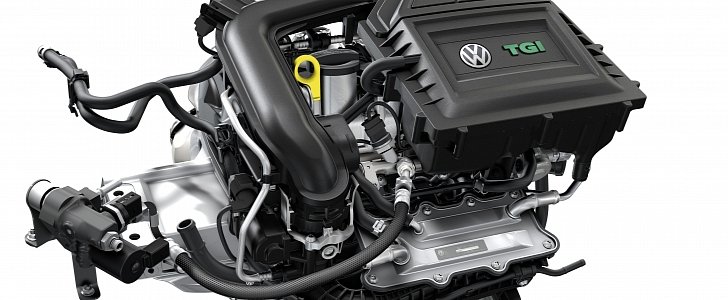The 1.4 TGI engine is available across all four Volkswagen Group brands that use the MQB platform. But now, there's a smaller unit. The 1.0 TGI was unveiled today at the 38th Vienna Motor Symposium, and it's not just for emerging markets.
VW might say that electric cars will become viable soon, but it's making the transition to sustainable mobility with compressed natural gas (CNG).
A key part of making this engine as clean as possible is bringing the catalytic converter quickly up to operating temperature. The lambda prove has an electric heating system, thus making it functional within ten seconds of a cold start even if exhaust gas and exhaust system still contain certain amounts of condensation.
Now that we got the boring stuff out of the way, let's see what sort of compromise you'll be making. The architecture is, of course, the same as the 1.0 TSI, a 3-cylinder motor with a small turbo. But you do need different internals to cope with the specific lubrication needs of CNG engines.
Still, at least it's not down on power, as 90 PS is nearly identical to the regular TSI. The compact 1.0 TGI is a new engine specification for the small car class in the Volkswagen Group. That could mean it's going in the Polo, but we've heard the South American Gol or Up! will use it first.
A key part of making this engine as clean as possible is bringing the catalytic converter quickly up to operating temperature. The lambda prove has an electric heating system, thus making it functional within ten seconds of a cold start even if exhaust gas and exhaust system still contain certain amounts of condensation.
But what makes burning gas different to regular gasoline or diesel?
"Due to its chemical composition, natural gas as a fuel already reduces CO2 emissions if it comes from fossil sources. If, however, it is produced in a sustainable way, for instance as biomethane from agricultural waste, then looked at from well-to-wheel it facilitates a form of mobility that produces appreciably less CO2. We use the term e-gas to describe synthetically produced CNG that is made out of water and CO2 from renewable power generation's excess current. e-gas is ideal for making renewable power usable for the transport sector and for storing it. It is in practical terms a partner in the switch to renewable forms of energy," says Dr Wolfgang Demmelbauer-Ebner, Head of Volkswagen Petrol Engine Development.Now that we got the boring stuff out of the way, let's see what sort of compromise you'll be making. The architecture is, of course, the same as the 1.0 TSI, a 3-cylinder motor with a small turbo. But you do need different internals to cope with the specific lubrication needs of CNG engines.
Still, at least it's not down on power, as 90 PS is nearly identical to the regular TSI. The compact 1.0 TGI is a new engine specification for the small car class in the Volkswagen Group. That could mean it's going in the Polo, but we've heard the South American Gol or Up! will use it first.





